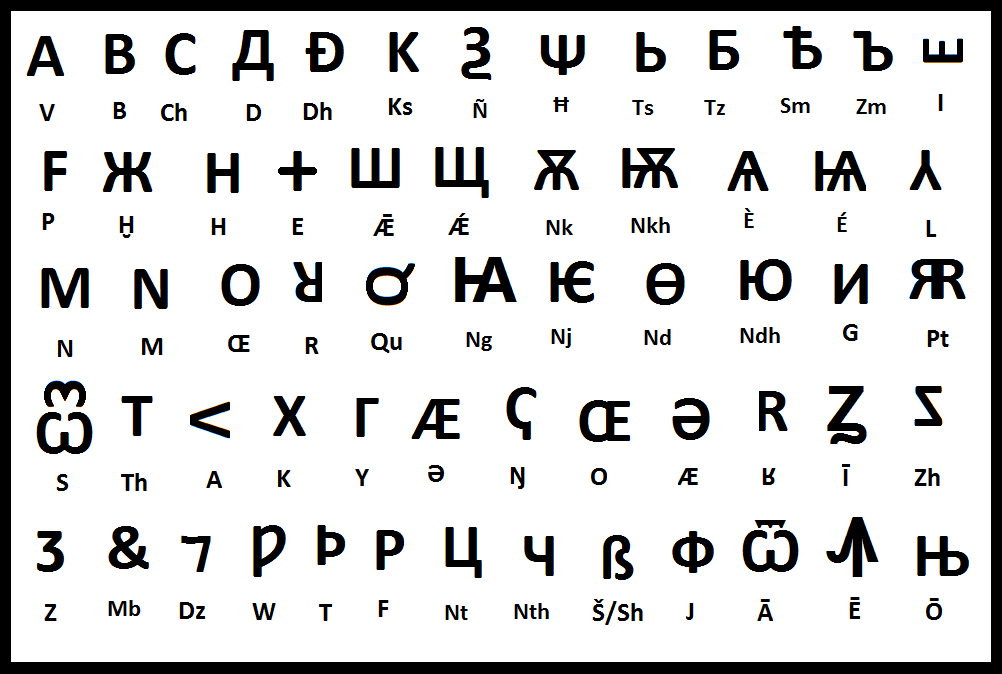Although the Old Folk vanished 50 years ago, their languages still remain.
Some say the language of the Folk was very similar to ours, some say it was a pidgin language made to speak with the aborigines of the archipelago now known as Heimland (an Old Folk word meaning "Homeland").
The language itself has split into two main familes; the Geeta (six languages of the forests) and the High-Talk (including Lowtalk and Lowertalk). It is said that the High-Talk was once the original lingua-franca of the island, but it split up into two families when the Folk vanished. The Geeta split into six more dialects later on. Other language, such as
Karakeya, formed from the two language-families. It is said that B33P3R, the preferred language of machines, is an electronic form of pure High-Talk.
Writing System
The alphabet, known as the Folk-Script, appears vaguely similar to English and Cyrillic alphabets. Words written in this script can be found in posters and books left behind by the Old Folk. There are 60 letters in total. The letters are “V”, “B”, Ch”, “D”, “Д, “Ks”, “Ñ”, ‘Ħ”, “Ts”, “Tz, “Sm”, “Zm”, “I”, “P”, ‘Ḫ”, “H”, “E”, “Ǣ”, “Ǽ”, “Nk”, “Nkh”, ‘È”, “É”, “L”, “N”, “M”, “Œ”, “R”, “Qu”, “Ng”, “Nj”, “Nd”, “Ndh”, “G”, “Pt”, “S”, “Th”, “A”, “K”, “Y”, “Ə”, “Ŋ”, “O”, “Æ”, “ʁ”, “Ī”, “Zh”, “Z”, “Mb”, “Dz”, “W”, “T”, “F”, “Nt”, “Nth”,“Š/Sh”, "J", "Ā", "Ē" and "Ō". The "Zh" is pronounced like "Ž", "Pt" is a thick sound representing the hard "T" sound like in "Pterygium". “Д is pronounced as "Dh". The structure of the Folk-Script is rather like English, but long double-letters (e.g. "TT" or "LL") are indicated with a dot marked over the single letter. The script is written from top to bottom in vertical columns and left to right or right to left in horizontal rows. The Folk-Script is rarely used in Heimland anymore, and those who can read and write it are held in high regard.
The Folk-Script:

by C.S.De Silva (Ken D)
With a complex set of phonemes (such as the infamous "Ks" sound which can only be made by shaping your mouth to produce a "k" sound but instead says "s" whilst whistling. Only the Yea'haa'weh and Vedda have perfected the sound), certain sounds are difficult to pronounce for non-native speakers.The language has no restricted phonemes; sounds like "ŋ" (the sound pronounced at the end of "sing") are sometimes spoken in front of a word and sounds like "ʁ" (a deep guttural "R" pronounced at the far back of the throat) can be pronounced before consonants. The language has a lot of nasal sounds (such as mb, ng, nj, nd, ndh, nk, nkh, nt and so on).
The language is tonal, meaning certain sounds can have multiple meanings and must be pronounced differently. For example: "bang" (meaning cigarette) can be pronounced as bangg (with extended vowel) meaning explosion. Affixes are almost nonexistent in the language; instead, root-words could be pronounced any way the speaker desires. Sometimes two stem-words can be pronounced together in one form for emphasis (e.g. "tak", meaning the stem-word "take", can be said as "tak'tak", meaning "takes" or "taktak" meaning "take" in present-tense)
The structure of sentences are either "Object-Verb-Subject" or "Subject-Object-Verb", depending on tone and context. For example; "Kan taktak ahla wanmin min himm en tow" roughly translates to "Water-bucket take a water for him to wash", but in context a speaker could understand the message easily. Sayings or phrases like "Tə meyŋ əlevit pəyt ərkən" meaning "Jolly/Happy today sunny day morning" could also be interpreted with ease.
The vocabulary of the language of the Old Folk is simple in its roots. There are multiple words for one meaning. Some words are stringed together to form completely different words, others are seperated and broken down. Some words are accompanied by a "toner" (a stem-word used for emphasis, such as "ne" or "əə").










Comments